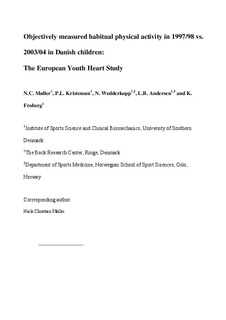| dc.contributor.author | Møller, Niels C. | |
| dc.contributor.author | Kristensen, Peter Lund | |
| dc.contributor.author | Wedderkopp, Niels | |
| dc.contributor.author | Andersen, Lars Bo | |
| dc.contributor.author | Froberg, Karsten | |
| dc.date.accessioned | 2009-04-30T10:30:18Z | |
| dc.date.issued | 2008-02-17 | |
| dc.identifier | Seksjon for idrettsmedisinske fag / Department of Sports Medicine | |
| dc.identifier.citation | Scandinavian Journal of Medicine & Science in Sports. 2008, 19(1), 19-29 | en |
| dc.identifier.issn | 0905-7188 | |
| dc.identifier.uri | http://hdl.handle.net/11250/170441 | |
| dc.description | I Brage finner du siste tekst-versjon av artikkelen, og den kan inneholde ubetydelige forskjeller fra forlagets pdf-versjon. Forlagets pdf-versjon finner du på www.blackwell-synergy.com: http://dx.doi.org/10.1111/j.1600-0838.2008.00774.x / In Brage you'll find the final text version of the article, and it may contain insignificant differences from the journal's pdf version. The definitive version is available at www.blackwell-synergy.com: http://dx.doi.org/10.1111/j.1600-0838.2008.00774.x | en |
| dc.description.abstract | Based on two cross-sectional studies conducted in 8–10-year-old third-grade children living in the municipality of Odense, potential differences were examined in the level of habitual physical activity (HPA) in Danish children between 1997/1998 and 2003/2004. HPA was assessed objectively by accelerometry. Primarily, overall differences were analyzed as gender and day type specific (i.e. Mon–Thu vs Fri–Sun) levels in HPA. Secondarily, differences were analyzed across socioeconomic gradients defined according to parents' occupation. Data were expressed as total counts per registered time. During the period 1997/1998–2003/2004, no significant differences were observed in the level of HPA during Mon–Thu or Fri–Sun or across socioeconomic gradients. Post hoc analyses indicated a slightly more favorable ratio between the percentages of time spent in light and moderate intensity levels during Mon–Thu in 2003/2004 when compared with 1997/1998. Gender differences in the level of HPA were found to be more distinct during Mon–Thu than during Fri–Sun. This study does not support the idea that Danish children are becoming less physically active. However, a limited statistical power should be considered when interpreting differences across socioeconomic gradients. Boys were found to be more physically active than girls, especially during the weekdays (Friday not included). | en |
| dc.format.extent | 178958 bytes | |
| dc.format.mimetype | application/pdf | |
| dc.language.iso | eng | en |
| dc.publisher | John Wiley & Sons | en |
| dc.subject | activity behavior | en |
| dc.subject | trends | en |
| dc.subject | accelerometers | en |
| dc.subject | child | en |
| dc.subject | socioeconomic status | en |
| dc.subject | epidemiology | en |
| dc.title | Objectively measured habitual physical activity in 1997/1998 vs 2003/2004 in Danish children: The European Youth Heart Study | en |
| dc.type | Peer reviewed | en |
| dc.type | Journal article | en |
| dc.subject.nsi | VDP::Social science: 200::Social science in sports: 330::Other subjects within physical education: 339 | en |
| dc.source.pagenumber | 19-29 | en |
| dc.source.volume | 19 | en |
| dc.source.journal | Scandinavian Journal of Medicine & Science in Sports | en |
| dc.source.issue | 1 | en |
